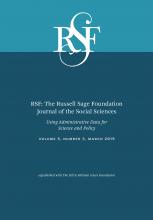Research Article
Open Access
Are They Still Worth It? The Long-Run Earnings Benefits of an Associate Degree, Vocational Diploma or Certificate, and Some College
Changhwan Kim, Christopher R. Tamborini
RSF: The Russell Sage Foundation Journal of the Social Sciences March 2019, 5 (3) 64-85; DOI: https://doi.org/10.7758/RSF.2019.5.3.04
Changhwan Kim
aProfessor in the Department of Sociology at the University of Kansas
Christopher R. Tamborini
bSenior researcher in the Office of Research, Evaluation, and Statistics at the U.S. Social Security Administration

REFERENCES
- ↵
- Baum, Sandy,
- Charles Kurose, and
- Michael McPherson
- ↵
- ↵
- Belfield, Clive R
- ↵
- Blom, Erica,
- Briand C. Cadena, and
- Benjamin J. Keys
- ↵
- Brand, Jennie E., and
- Yu Xie
- ↵
- ↵
- ↵
- Davies, Scott, and
- Neil Guppy
- ↵
- DiPrete, Thomas A., and
- Claudia Buchmann
- ↵
- Dougherty, Christopher
- ↵
- Dougherty, Kevin J
- ↵
- Dougherty, Kevin J
- ↵
- Dougherty, Kevin J
- ↵
- Fischer, Claude S., and
- Michael Hout
- ↵
- Gerber, Theodore P., and
- Sin Yi Cheung
- ↵
- Gill, Andrew M., and
- Duane E. Leigh
- ↵
- ↵
- Grubb, W. Norton
- ↵
- Grusky, David B.,
- Michael Hout,
- Timothy M. Smeeding, and
- C. Matthew Snipp
- ↵
- ↵
- ↵
- Jaggars, Shanna Smith, and
- Di Xu
- ↵
- Jepsen, Christopher,
- Kenneth Troske, and
- Paul Coomes
- ↵
- Kane, Thomas, and
- Cecilia Rouse
- ↵
- Kena, Grace,
- Lauren Musu-Gillette,
- Jennifer Robinson,
- Xiaolei Wang,
- Amy Rathbun,
- Jijun Zhang,
- Sidney Wilkinson-Flicker,
- Amy Barmer, and
- Erin Dunlop Velez
- ↵
- Kim, ChangHwan, and
- Christopher R. Tamborini
- ↵
- ↵
- Kristal, Tali,
- Yinon Cohen, and
- Guy Mundlak
- ↵
- Liu, Vivian Y. T.,
- Clive R. Belfield, and
- Madeline J. Trimble
- ↵
- ↵
- ↵
- Marcotte, Dave E.,
- Thomas Bailey,
- Carey Borkoski, and
- Greg S. Kienzl
- ↵
- ↵
- Monk-Turner, Elizabeth
- ↵
- ↵
- ↵
- Rosenbaum, James E.,
- Caitlin E. Ahearn, and
- Janet E. Rosenbaum
- ↵
- Sandefur, Gary D., and
- Hyunjoon Park
- ↵
- ↵
- Tamborini, Christoper R., and
- ChangHwan Kim
- ↵
- ↵
- Torche, Florencia
- ↵
- Vuolo, Mike,
- Jeylan T. Mortimer, and
- Jeremy Staff
- ↵
- ↵
In this issue
Are They Still Worth It? The Long-Run Earnings Benefits of an Associate Degree, Vocational Diploma or Certificate, and Some College
Changhwan Kim, Christopher R. Tamborini
RSF: The Russell Sage Foundation Journal of the Social Sciences Mar 2019, 5 (3) 64-85; DOI: 10.7758/RSF.2019.5.3.04
Jump to section
Related Articles
- No related articles found.
Cited By...
- No citing articles found.





